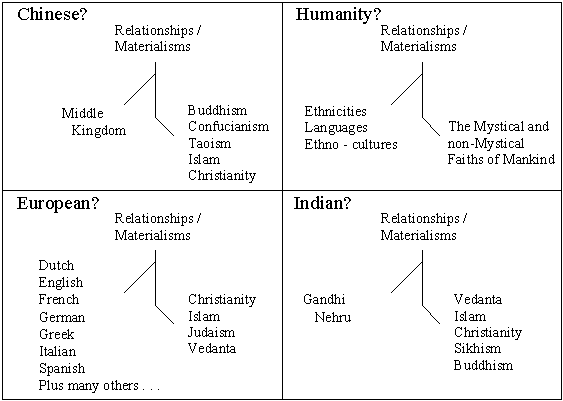Social Identity Theory
Tajfel and Turner 1979
In 1979 Henri Tajfel and John Turner proposed a Social Identity Theory which held that there are three cognitive processes relevant to a
persons being part of an in-group, or of an out-group. Such group membership being, depending upon circumstances, possibly associable with
the appearance of prejudice and discrimination related to such perceived group membership.
- Social Categorisation
- The process of deciding which group you or "another person or persons" belongs to. At its most basic and non-involved level "any group will do"
and no necessity is seen for conflict between groups.
- Social Identification
- The processes by which you or "another person or persons" identify with an in-group more overtly. The norms and attitudes of other members within that
group being seen as compatible with your own or worthy of emulation by yourself, or as compatible with those of "another person or persons"
or seen as being by open to emulation by "another person or persons".
- Social Comparison
- Your own self-concept or the social concept of "another person or persons" becomes closely meshed in with perceptions of group membership.
Self-esteem, or the estimate of "another person or persons" is enhanced or detracted from by perceptions of how in-groups and out-groups
are held to behave or are held to be able to perform or to rate in society.

According to Social Identity Theory, social comparison with the outgroup is a decisive element in the process by which social categorization can turn into the creation of positive ingroup distinctiveness.
Although much broader in its scope, Social Identity Theory is closely associated with earlier experiments conducted by Henri Tajfel and others
into the so-called Minimal Group Paradigm.
This paradigm, where a number
of assumptions, concepts, values or practices were accepted in order to better allow a view of reality in relation to the onset of human group
formation and of the appearance of discriminatory behaviours was originally planned to provide a baseline in order to test subsequently the
necessary and sufficient conditions for in-group favoritism and out-group derogation.
Intergroup behaviour was analyzed in a situation
of "mere categorization" such as where people involved as subjects in this research were told that they were individually
"overestimators" or "underestimators" of the number of dots in a display.
It was found that even under very flimsy and apparently baseless assigned social categorisation into two distinct,
and previously "unheard of" social categories, in-group favoritism and out-group derogation occured in the distribution, by the research subjects, of
"rewards for participation" in the study.
This held true even where there was neither
intra-group or inter-group interaction nor any opportunity to directly fulfil self-interests through such allocations
or evaluations of such "rewards for participation". The finding in these earlier studies, which have often been replicated by other researchers,
show that under even under meaningless social categorisation conditions in-group favoritism and
out-group derogation tended to routinely occur.
Social Identity Theory offers an explanation for the so-called "mere categorization effect" by postulating a need for positive social identity.
By treating or evaluating in-group members more favourably than out-group members, social identity can be ensured or enhanced.
It is assumed that the self-concept comprises two components, personal and
social identity. A person may be held to inter-act with wider society simultaneously as an individual and as a member of
any groups he or she might feel that they belonged to. This might even well extend to an individual feeling for any trials, tribulations
or triumps which he or she perceives as being experienced by any groups he or she might feel that they belonged to.
Such assumptions allow Social Identity Theory to be extended into an area known as Conflict Theory and hence into the realms of poitics and
statemanship.
It seems that Tajfel accepted that we live in a world alive with the possibility of prejudice or discrimination aligned with
groups and group perceptions, nevertheless Tajfel saw groups as being positive in that they could well give those subject to prejudice or
discrimination aligned with groups and group perceptions the means, in co-operation with fellow group members,
of seeking to improve their position as individuals and as a group.
Human Psychology

It is widely known that Plato, pupil of and close friend to Socrates, accepted that Human
Beings have a " Tripartite Soul " where individual Human Psychology is composed of three aspects -
Wisdom-Rationality, Spirited-Will and Appetite-Desire.
What is less widely appreciated is that such major World Faiths as Christianity, Islam,
Hinduism and Buddhism see "Spirituality" as being relative to "Desire" and to "Wrath".
|
|
![[social identity theory, tajfel and turner 1979]](../enlightenment.gif)
![[social identity theory, tajfel and turner 1979]](../enlightenment.gif)